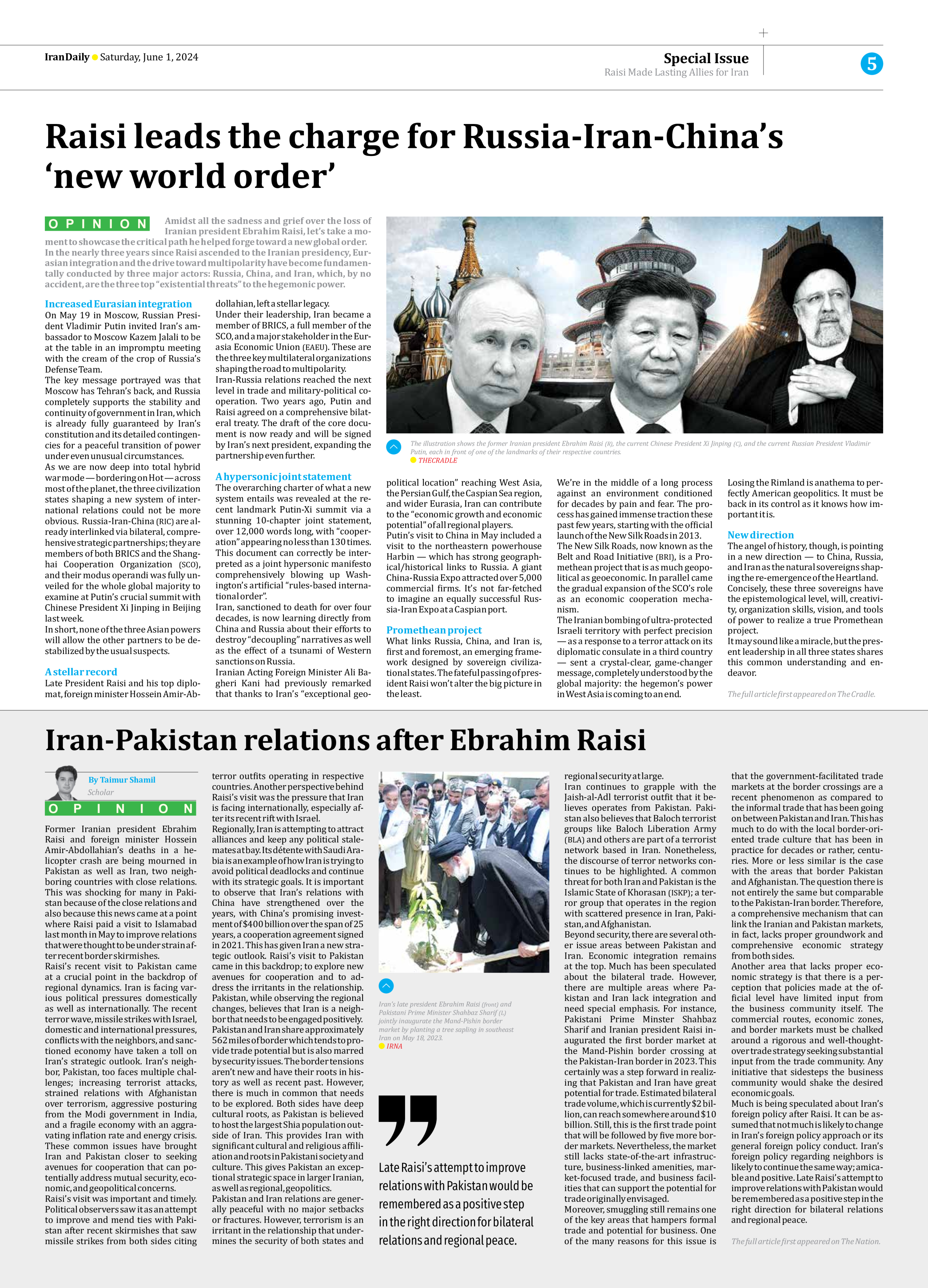
Raisi leads the charge for Russia-Iran-China’s ‘new world order’
Amidst all the sadness and grief over the loss of Iranian president Ebrahim Raisi, let’s take a moment to showcase the critical path he helped forge toward a new global order. In the nearly three years since Raisi ascended to the Iranian presidency, Eurasian integration and the drive toward multipolarity have become fundamentally conducted by three major actors: Russia, China, and Iran, which, by no accident, are the three top “existential threats” to the hegemonic power.
Increased Eurasian integration
On May 19 in Moscow, Russian President Vladimir Putin invited Iran’s ambassador to Moscow Kazem Jalali to be at the table in an impromptu meeting with the cream of the crop of Russia’s Defense Team.
The key message portrayed was that Moscow has Tehran’s back, and Russia completely supports the stability and continuity of government in Iran, which is already fully guaranteed by Iran’s constitution and its detailed contingencies for a peaceful transition of power under even unusual circumstances.
As we are now deep into total hybrid war mode — bordering on Hot — across most of the planet, the three civilization states shaping a new system of international relations could not be more obvious. Russia-Iran-China (RIC) are already interlinked via bilateral, comprehensive strategic partnerships; they are members of both BRICS and the Shanghai Cooperation Organization (SCO), and their modus operandi was fully unveiled for the whole global majority to examine at Putin’s crucial summit with Chinese President Xi Jinping in Beijing last week.
In short, none of the three Asian powers will allow the other partners to be destabilized by the usual suspects.
A stellar record
Late President Raisi and his top diplomat, foreign minister Hossein Amir-Abdollahian, left a stellar legacy.
Under their leadership, Iran became a member of BRICS, a full member of the SCO, and a major stakeholder in the Eurasia Economic Union (EAEU). These are the three key multilateral organizations shaping the road to multipolarity.
Iran-Russia relations reached the next level in trade and military-political cooperation. Two years ago, Putin and Raisi agreed on a comprehensive bilateral treaty. The draft of the core document is now ready and will be signed by Iran’s next president, expanding the partnership even further.
A hypersonic joint statement
The overarching charter of what a new system entails was revealed at the recent landmark Putin-Xi summit via a stunning 10-chapter joint statement, over 12,000 words long, with “cooperation” appearing no less than 130 times.
This document can correctly be interpreted as a joint hypersonic manifesto comprehensively blowing up Washington’s artificial “rules-based international order”.
Iran, sanctioned to death for over four decades, is now learning directly from China and Russia about their efforts to destroy “decoupling” narratives as well as the effect of a tsunami of Western sanctions on Russia.
Iranian Acting Foreign Minister Ali Bagheri Kani had previously remarked that thanks to Iran’s “exceptional geopolitical location” reaching West Asia, the Persian Gulf, the Caspian Sea region, and wider Eurasia, Iran can contribute to the “economic growth and economic potential” of all regional players.
Putin’s visit to China in May included a visit to the northeastern powerhouse Harbin — which has strong geographical/historical links to Russia. A giant China-Russia Expo attracted over 5,000 commercial firms. It’s not far-fetched to imagine an equally successful Russia-Iran Expo at a Caspian port.
Promethean project
What links Russia, China, and Iran is, first and foremost, an emerging framework designed by sovereign civilizational states. The fateful passing of president Raisi won’t alter the big picture in the least.
We’re in the middle of a long process against an environment conditioned for decades by pain and fear. The process has gained immense traction these past few years, starting with the official launch of the New Silk Roads in 2013.
The New Silk Roads, now known as the Belt and Road Initiative (BRI), is a Promethean project that is as much geopolitical as geoeconomic. In parallel came the gradual expansion of the SCO’s role as an economic cooperation mechanism.
The Iranian bombing of ultra-protected Israeli territory with perfect precision — as a response to a terror attack on its diplomatic consulate in a third country — sent a crystal-clear, game-changer message, completely understood by the global majority: the hegemon’s power in West Asia is coming to an end.
Losing the Rimland is anathema to perfectly American geopolitics. It must be back in its control as it knows how important it is.
New direction
The angel of history, though, is pointing in a new direction — to China, Russia, and Iran as the natural sovereigns shaping the re-emergence of the Heartland.
Concisely, these three sovereigns have the epistemological level, will, creativity, organization skills, vision, and tools of power to realize a true Promethean project.
It may sound like a miracle, but the present leadership in all three states shares this common understanding and endeavor.
The full article first appeared on The Cradle.







